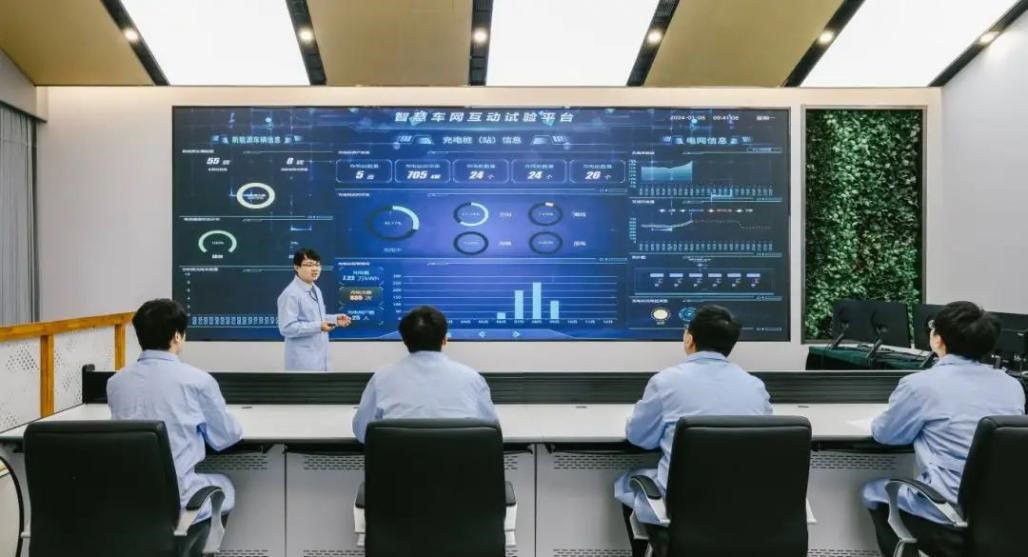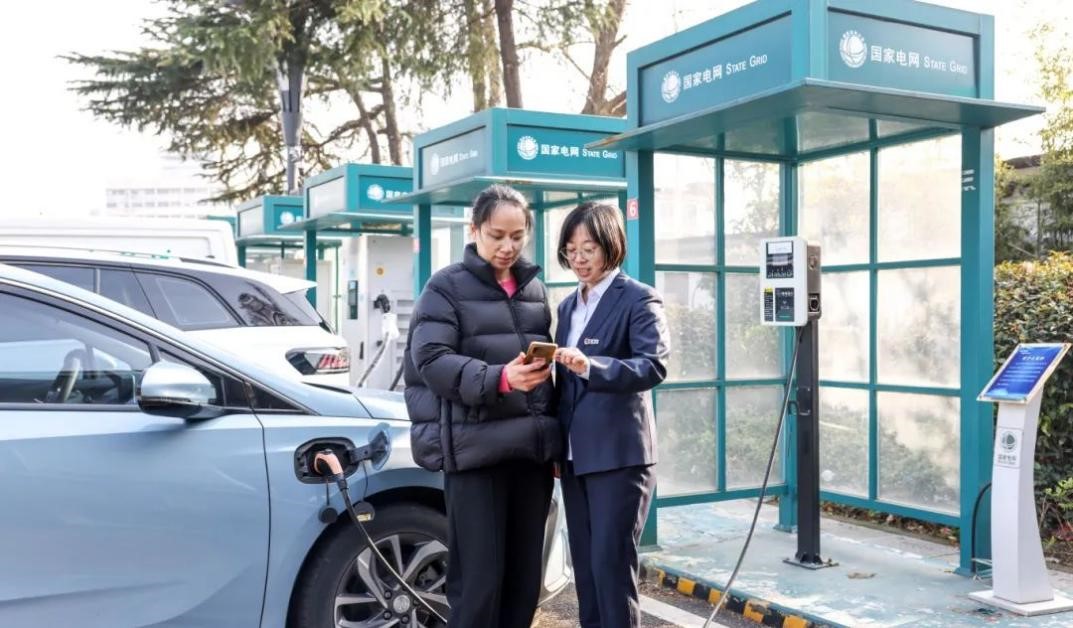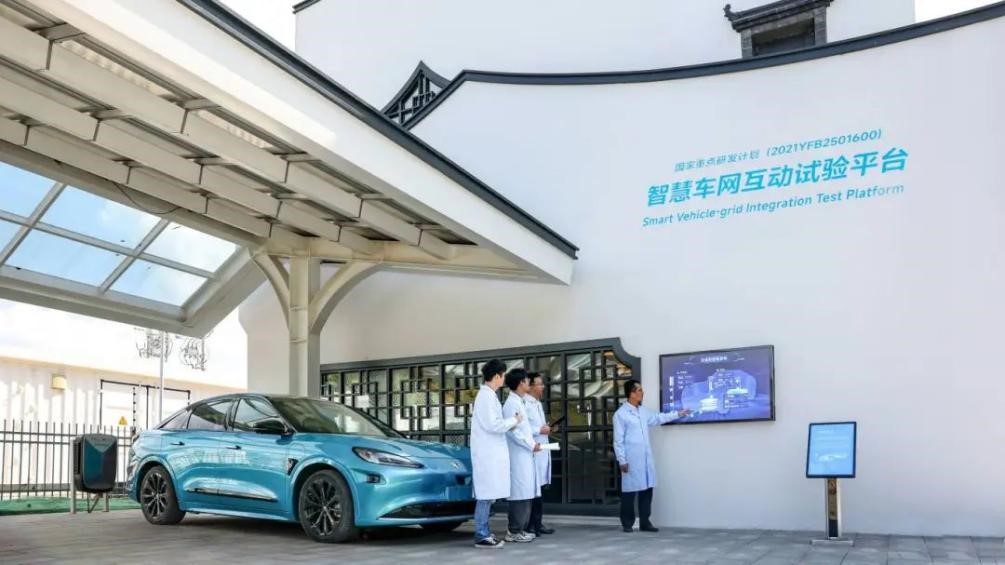




- BRNN
- BRI News
- BRNN News
- Database
Official Documents Polices and Regulations
Inter-government Documents International Cooperation BRI Countries
Business Guide Economic Data BRI Data
Trade
Investment Projects Latest projects
Cases - Content Pool
China's first smart electric vehicle (EV) charging and battery-swapping demonstration zone was completed in east China's Jiangsu province. The zone covers nearly 500 square kilometers in the cities of Suzhou, Wuxi and Changzhou. With about 1,300 charging piles, it serves over 500,000 new energy vehicle (NEV) drivers.
Through efficient interaction among NEVs, charging and battery-swapping stations, and urban power grids, smart EV charging and battery-swapping improves the utilization efficiency of charging piles and reduces the waiting time for drivers.

Researchers with the electric power research institute of State Grid Jiangsu Electric Power Co., Ltd. study intelligent vehicle-to-grid technology. (Photo from China Electric Power News)
While providing a convenient and efficient charging and battery-swapping experience to users, it promotes the healthy development of the NEV market and contributes to the green and smart development of the transportation sector.
"This app can guide me to the nearest charging station that saves me the most waiting time. It also tells me the number of vacant charging piles at the station and the period when the charging fee is at the lowest," a tourist surnamed Li told People's Daily at a public charging station in Binhu district, Wuxi.
According to Li, she drove all the way to Wuxi from Jiangsu's Changshu. When she arrived in Wuxi, she found her vehicle had only 30 percent of electricity left, and then she was guided to the charging station with the mobile application echargenet.
"It's around 10 a.m., and the charging price is 1.17 yuan ($0.16) per kWh, with a service fee of 0.51 yuan per kWh. Using a 50 percent discount coupon provided by the platform for the service fee, it saves me over 10 yuan on a full charge," Li said.
In the past, she always chose the charging station nearest to her when the battery ran low, so she had no way to know whether there were vacant charging piles. When there were many vehicles waiting to be charged, she had to look for other stations.

A staff member of the electric power research institute of State Grid Jiangsu Electric Power Co., Ltd. guides a woman to use smart charging services at a charging station in Wuxi, Jiangsu province. (Photo from China Electric Power News)
Yuan Xiaodong, senior technical director of the electric power research institute of State Grid Jiangsu Electric Power Co., Ltd., said that smart charging for EVs integrates and regulates distributed resources within the broader power grid. This includes data aggregation analysis for "vehicle-station-grid," collaborative planning of network layouts, and an AI platform for operational decision-making.
Specifically, the echargenet app utilizes various algorithm models to provide optimal recommendations based on factors such as driving habits, traffic conditions, and power load on the grid. It can predict when a vehicle's battery will drop to the charging threshold, offering users with plans that are most time-saving and economical.
If there are long lines of vehicles waiting at a charging station during a specific time period, the platform will issue discount coupons to users based on their preferences, thus guiding parts of them to nearby stations with more vacant piles and reducing the electricity load at one single station.
In Xinwu district, Wuxi, there is a vehicle-to-grid (V2G) interactive verification base, whose first phase functions as a solar farm, power storage station, charging station and reverse charging station. It has established a multi-energy management system to uniformly monitor and manage the operation of these systems.
Some other bases of this type are also capable of performing battery testing while the vehicles are being charged.

Staff members of the electric power research institute of State Grid Jiangsu Electric Power Co., Ltd. explore wireless charging and discharging technology for electric vehicles. (Photo from China Electric Power News)
Liu, who has an NEV, noticed a significant decline in his car's range. Recently, while charging his car at a charging station on Sheng'an Road in Wuxi, he was informed that battery testing could be conducted during the charging process without needing to remove the battery. Therefore, Liu opted for a quick test. About 20 minutes later, he received a report on his vehicle's power battery.
The report indicated that the coulombic efficiency of the battery of Liu's vehicle was at a relatively poor level of approximately 92.62 percent, while the energy efficiency was about 88.77 percent, which barely met the standard. Liu was advised to visit a dealer for battery maintenance.
In long-distance driving, there is an increasingly evident need for battery swapping. As each NEV model has a different battery type, comprehensive battery swapping stations are particularly necessary.
The second phase of the V2G interactive verification base in Wuxi is currently under construction, which includes a dedicated battery swapping area. This area will feature battery storage that supports battery swapping for mainstream NEVs. When an NEV enters the swapping area, the battery storage will automatically call up the appropriate battery based on its model, and the entire swapping process will be carried out by robots, taking only about three minutes.
Furthermore, the second phase of the base is expected to include facilities such as mobile charging and testing piles, comprehensive energy stations, and 1,000 kW supercharging piles. This will create an innovative base for intelligent microgrid systems and a demonstration area for collaborative micro-energy solutions with diverse elements and scenarios.

Tel:86-10-65363107, 86-10-65368220, 86-10-65363106